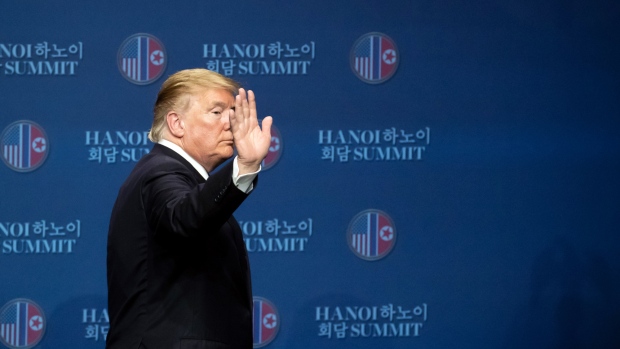Feb 28, 2019
Summit collapse: How Trump's Hanoi talks with Kim unraveled
, Bloomberg News

President Donald Trump arrived at the Metropole hotel in downtown Hanoi on Thursday ready to strike at least a modest deal with Kim Jong Un that would nudge North Korea closer to giving up its nuclear arms.
A document had been prepared, ready for the two leaders to sign in a much-anticipated ceremony before reporters. Progress had been made on a joint definition of “denuclearization,” Trump said -- a major sticking point in the talks. The North Korean leader assured the president he’d continue to suspend tests of nuclear bombs and ballistic missiles.
Then Kim decided to press his luck, in the president’s telling. And Trump walked away.
The young North Korean leader had been successful before with surprise requests for last-minute concessions. In Singapore, he persuaded Trump to halt joint military exercises with South Korea in the closing hours of their first summit.
This time, he went for more. Trump said Kim wanted the U.S. to lift all of its punishing economic sanctions against Pyongyang immediately. In exchange, North Korea would disable its Yongbyon reactor facility that had produced the fissile material for its nuclear bombs.
Trump, by his own account, was impressed that Kim was willing to lose a “very big” facility. But he said he pressed Kim on other nuclear sites uncovered by American intelligence. Moreover, the U.S. side -- mindful of North Korea’s track record of broken promises -- sought a different sequence of events: disarmament, then sanctions relief.
The North Koreans were unwilling to concede to the full inspections regime the U.S. proposed. As the sides went back and forth, reporters were brought into a cafe at the hotel where Trump and Kim were expected to share lunch. A long table with white linens and roses had been set, while a menu of snow fish, apple foie gras jelly, and banoffee pie was being prepared.
Back in the meeting room, the two leaders discussed whether to push forward with a deal. And Trump, who had for months been counseled by North Korea hawks within his administration, including National Security Adviser John Bolton, that no deal was preferable to a bad deal, began to balk.
He worried that an agreement perceived as lopsided in favor of Pyongyang would result in more media criticism. So Trump pulled a classic Trump move, abandoning the talks.
Canceled Ceremony
White House Press Secretary Sarah Sanders was dispatched to tell reporters there had been a change of schedule. The leaders were continuing to talk, but Trump’s news conference would move up two hours -- effectively replacing a signing ceremony for the two leaders’ agreement.
“They wanted the sanctions lifted, in their entirety,” Trump would later tell reporters. “And we couldn’t do that. They were willing to denuke a large portion of the areas that we wanted, but we couldn’t give up all the sanctions for that.”
The abrupt decision to curtail the summit seemed all the more jarring because Trump and Kim publicly demonstrated a warm rapport.
On Wednesday night, the pair laughed together as a group of international reporters scurried to snap pictures and shout questions during a series of photo ops. And they both adopted a defiant optimism, saying publicly that the talks would validate a diplomatic effort that has drawn skepticism in both countries.
Even their private discussions made clear Trump was willing to bend over backwards as he sought a deal. Trump told Kim that he believed he had no role in injuries sustained by a detained U.S. college student, Otto Warmbier, who died after he was returned to the U.S. in a comatose state following detention in North Korea. And the White House booted four American reporters from the leaders’ dinner on Wednesday after some of the journalists shouted questions at the pair during their initial photo ops.
Kim appeared more game to engage with journalists on Thursday, fielding a series of questions from White House reporters -- a historic first.
But one exchange seemed to portend the eventual collapse of the talks and underscored that despite the summit’s pageantry, the two leaders remained far apart on the details of an agreement.
Diplomatic Offices
A reporter asked Kim if he’d consider letting the U.S. open a diplomatic liaison office in Pyongyang, in exchange for a facility of his own in Washington. The North Korean leader initially demurred, indicating to Trump that he thought it was time for reporters to leave. But Trump told the North Korean he’d be interested to hear his answer.
Kim paused, then allowed that he might welcome the idea. But, he added, every minute of the summit was valuable, so it would be best for the journalists to leave.
In fact, there were fewer minutes left than Kim even knew. The talks collapsed shortly after reporters left the room, and in the end, the North Korean strongman left with only a parting handshake from the American president.
“We continue to work, and we’ll see,” Trump later told reporters. “But we had to walk away from that particular suggestion.”


